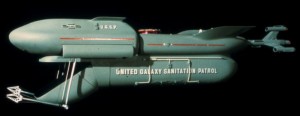This isn’t game related. Space garbage is a serious problem, a life-and-death problem. Bob Cringely has given the matter some serious thought:
We have to gather the stuff and bring it back to Earth. But how?
I propose a space garbage scow.
My garbage scow would use a very fine net to capture the debris and hold it. The net could be built from kevlar, but this week I’m making everything from carbon nanotubes, thanks, so that’s what we’ll use. Nanotubes have the highest strength-to-weight ratio of any material and would allow us to make a very large, very light weight net. Our point here is to make the net light rather than strong, since our capture speeds will be low and the lack of gravity ought to make it easy to keep the junk tethered together. The point of making it strong, then, is so it can be light enough to be big enough to maybe gather all the junk — all 18,000 pieces — into a single scow.
I imagine a seine purse-style net, if you know your commercial fishing. Launch the net into an inclined polar orbit generally higher than the space junk to be harvested. The polar orbit will ensure that eventually the scow will go over every spot on the Earth as the planet rotates below, but it also means the scow will eventually cross the path of every piece of space junk.
Here’s where we need an algorithm and a honking big computer, because this is a 3-D geometry problem with more than 18,000 variables. Our algorithm determines the most efficient path to use for gathering all 18,000 pieces of space junk.
I haven’t yet derived this algorithm, but I have some idea what it would look like. We’d start in a high orbit, above the space junk, because we could trade that altitude for speed as needed, simply by flying lower, trading potential energy for kinetic.
Dragging the net behind a little unmanned spacecraft my idea would be to go past each piece of junk in such a way that it not only lodges permanently in the net, but that doing so adds kinetic energy (hitting at shallow angles to essentially tack like a sailboat off the debris). But wait, there’s more! You not only have to try to get energy from each encounter, it helps if — like in a game of billiards or pool — each encounter results in an effective ricochet sending the net in the proper trajectory for its next encounter. Rinse and repeat 18,000 times.
It won’t always be possible, of course, to gain energy from each encounter, but that’s why we start in a higher orbit, so as energy is inevitably lost it can be replenished by moving to a lower orbit.
By the same token I think we would logically start with smaller bits of space junk so the net would gain mass steadily over time, then do the same again at each lower altitude. Eventually the net would have corralled hundreds of tons of debris, carrying it down into the atmosphere where atmospheric friction would eventually burn it all up in a spectacular visual display that would create a thin ring of fire all around the Earth.
It’s a crazy idea, sure, but it could work.
— Robert X. Cringely: Tossed in Space
— Via Slashdot
Then again, it should be a game. This is exactly the kind of situation where a game programmer could step forward and contribute to the solution of a real-world problem.
Somebody should make a flight simulator for the world’s first virtual Space Garbage Scow, the S.S. Cringely.
I’ll award the Handy Vandal’s Honorary Certificate of Merit to anyone who makes such a game!
I grew up on Asteroids … driving a garbage scow through a well-mapped volume of near-Earth space should be child’s play, compared to the random hazards and hostile UFOs of Asteroids.
